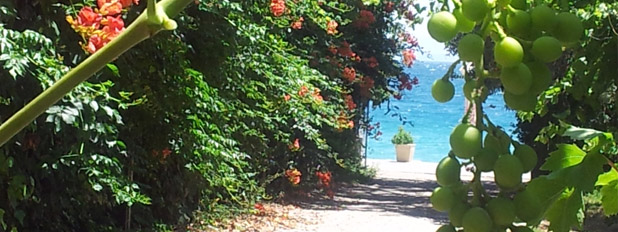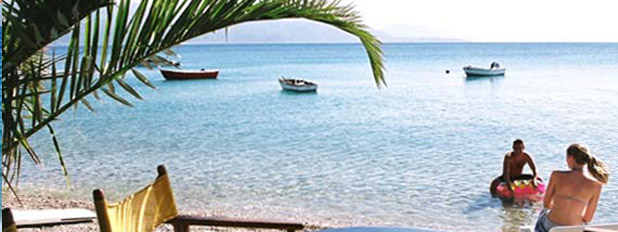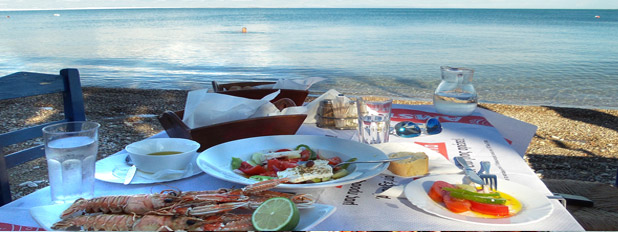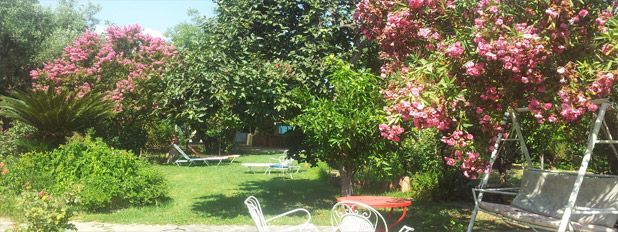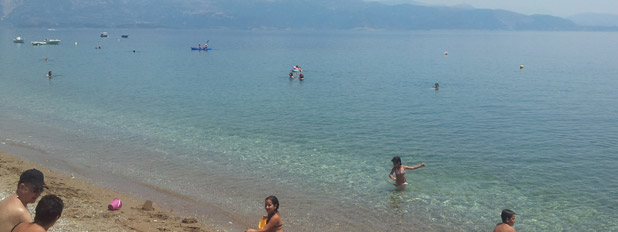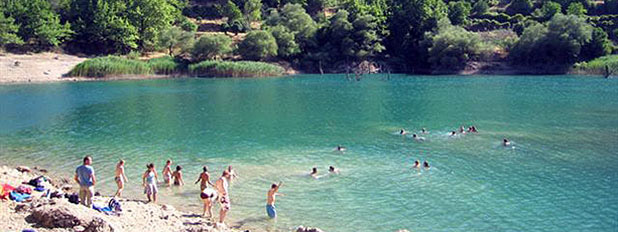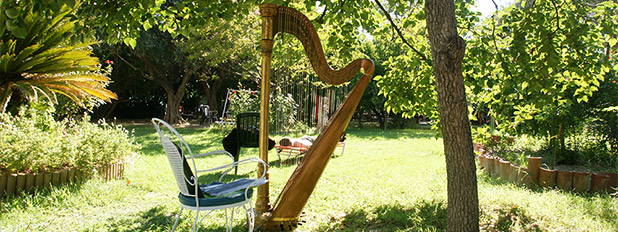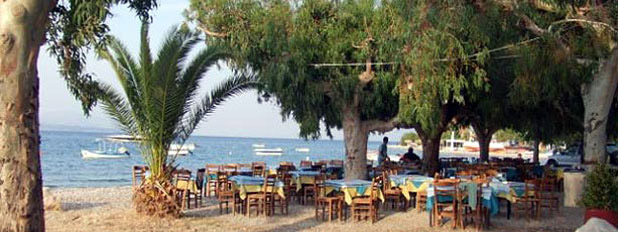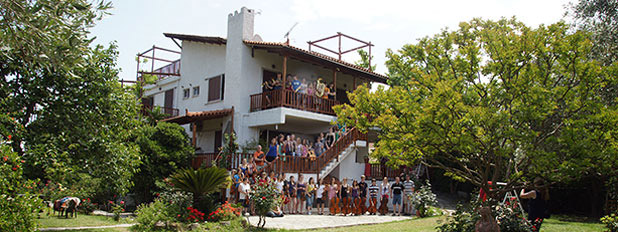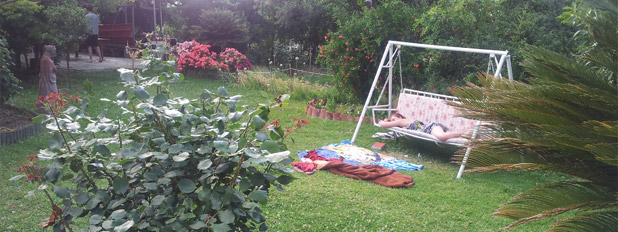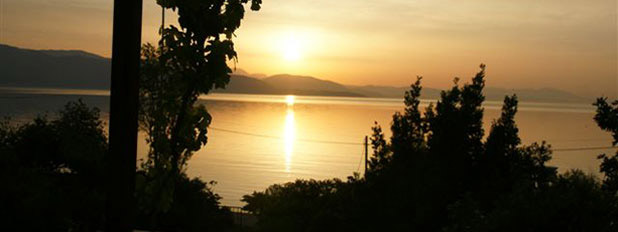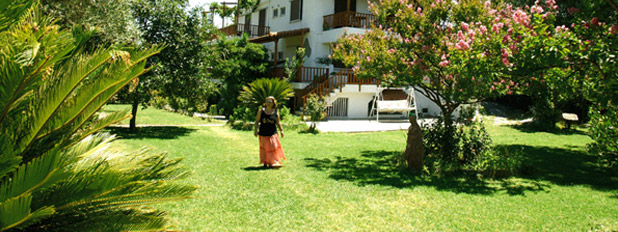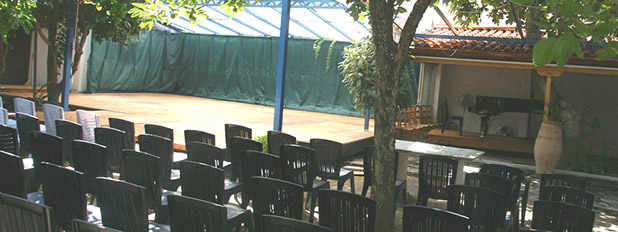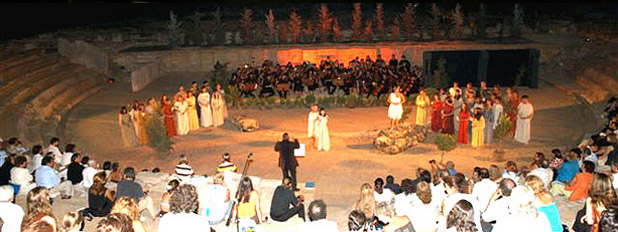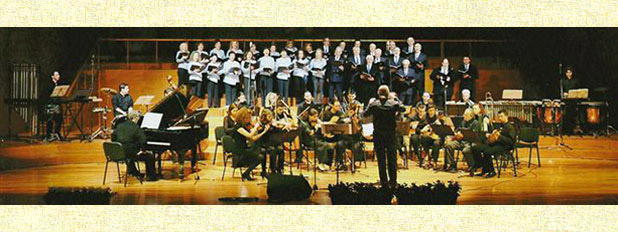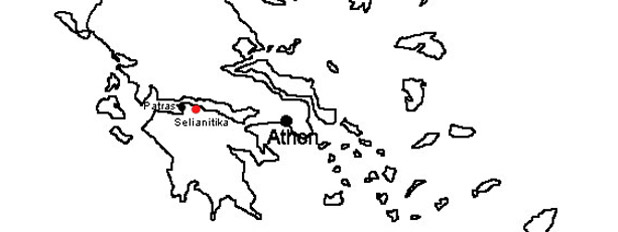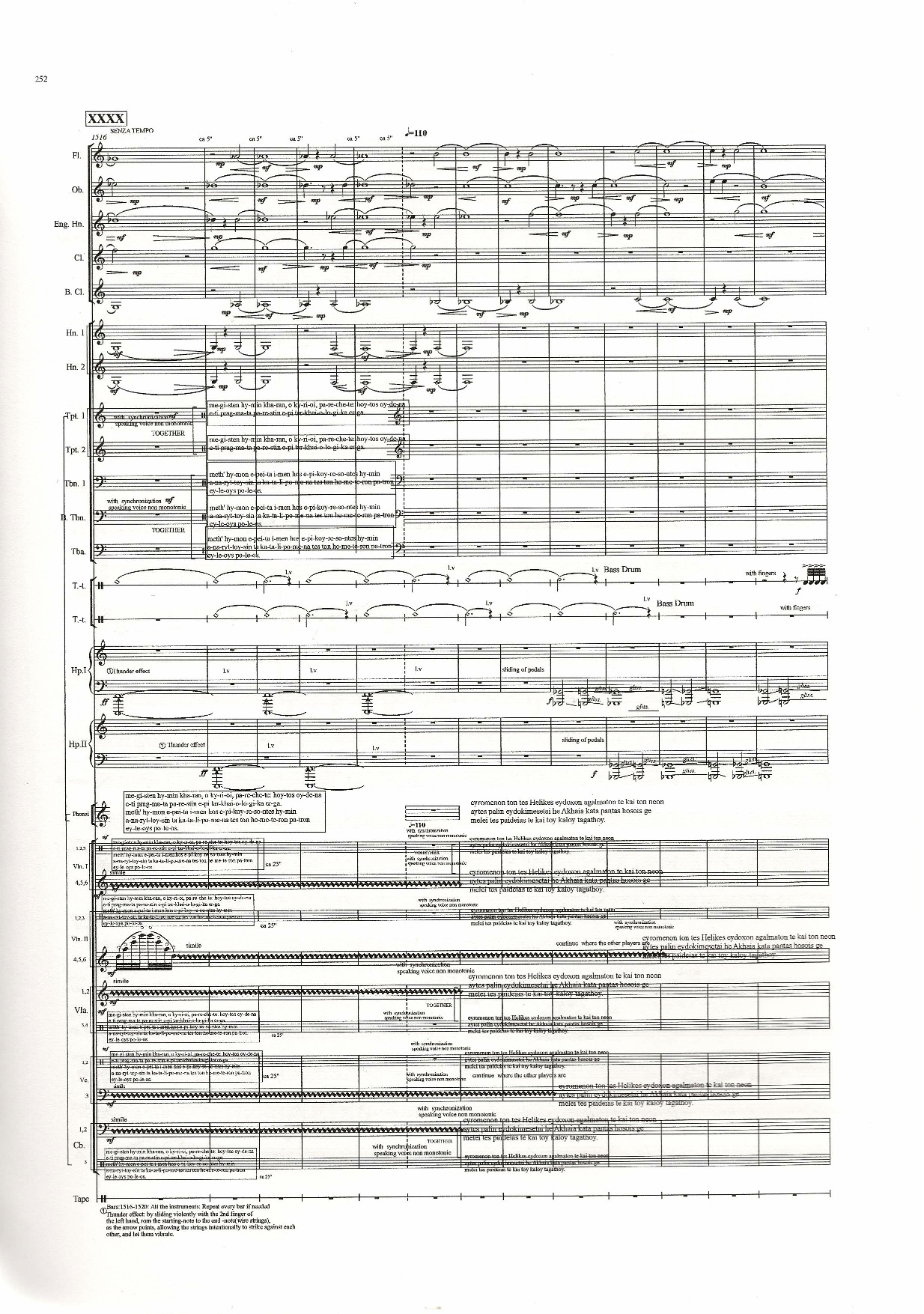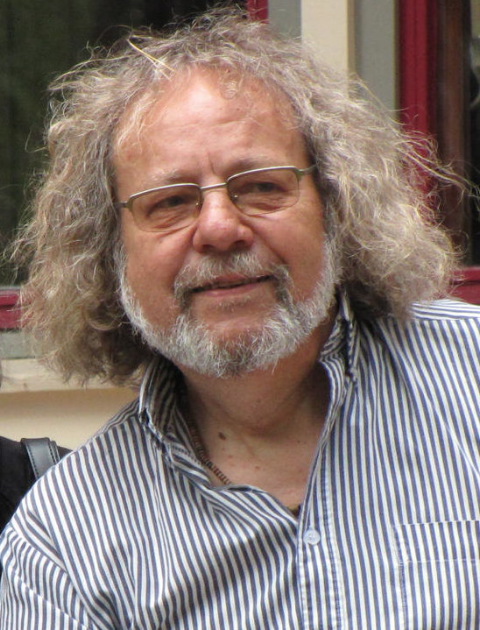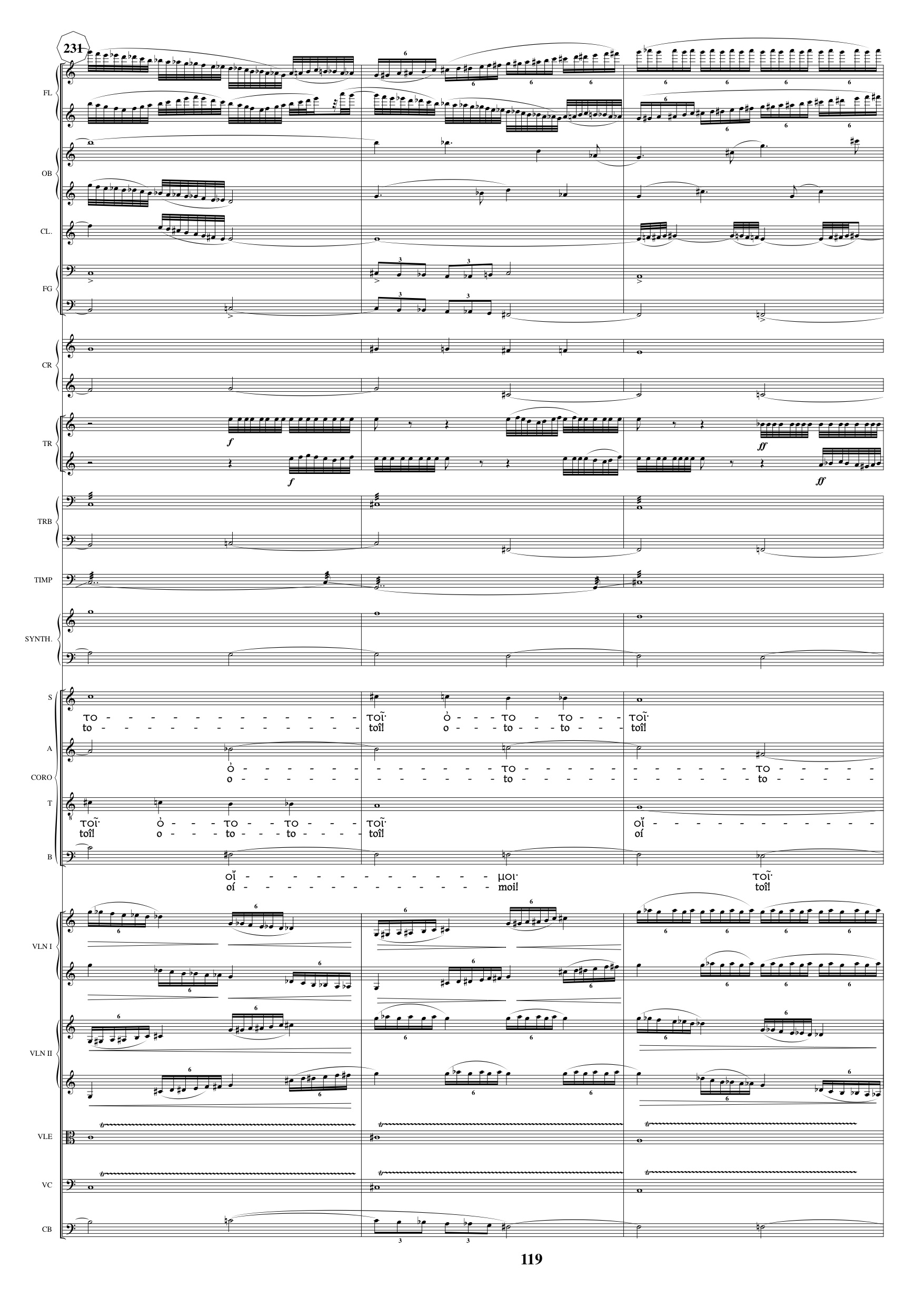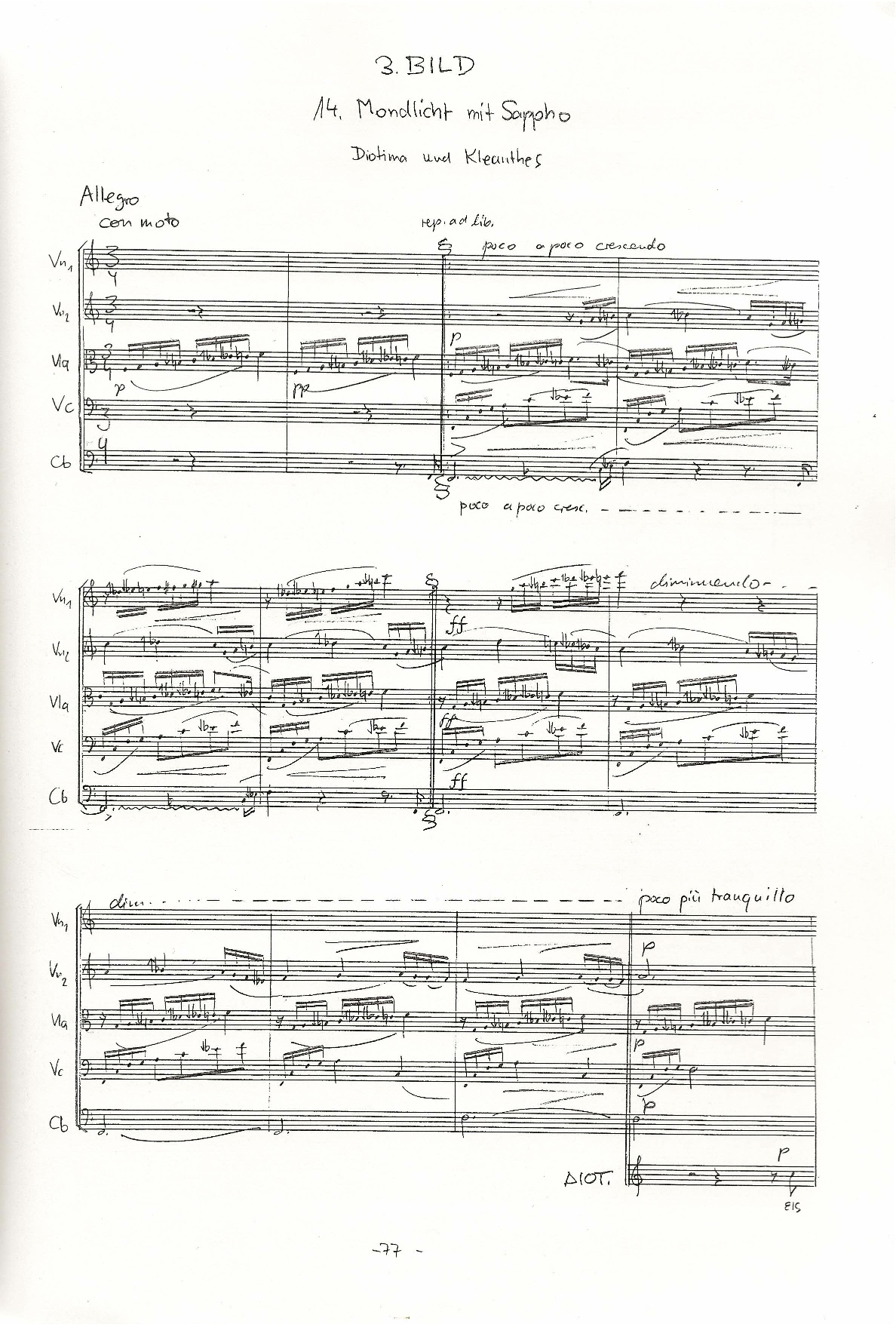Composition Competitions 2010
Invitation!
Orchestras and choirs, who are willing to perform one of the prize-awarded operas, have the opportunity to stay at "Hellenikon Idyllion" free of charges for 21 days in September, for final rehearsels and a performance of the opera in Greece.
INTERNATIONAL COMPOSITION COMPETITION
"HELIKE ATHANATOS",
"Helike – Immortal"
The story is based on an idea of Andreas Drekis,
Text and literatur - Libretto - in ancient Greek by Franz Knappik,
ANDREAS DREKIS AWARD - COMPOSITION
"HELLENIKON IDYLLION" in SELIANITIKA (GREECE), SEPTEMBER 29, 2010
JURY:
Werner Schulze, professor University of Music and Performing Arts Vienna, composor, Austria
Alois Springer, conductor, Germany
Dr. Spyros Mazis, composor, Greece
For more details about the composition competition:composition competition 2010
Results of the Compositionscompetition 07.10.2010
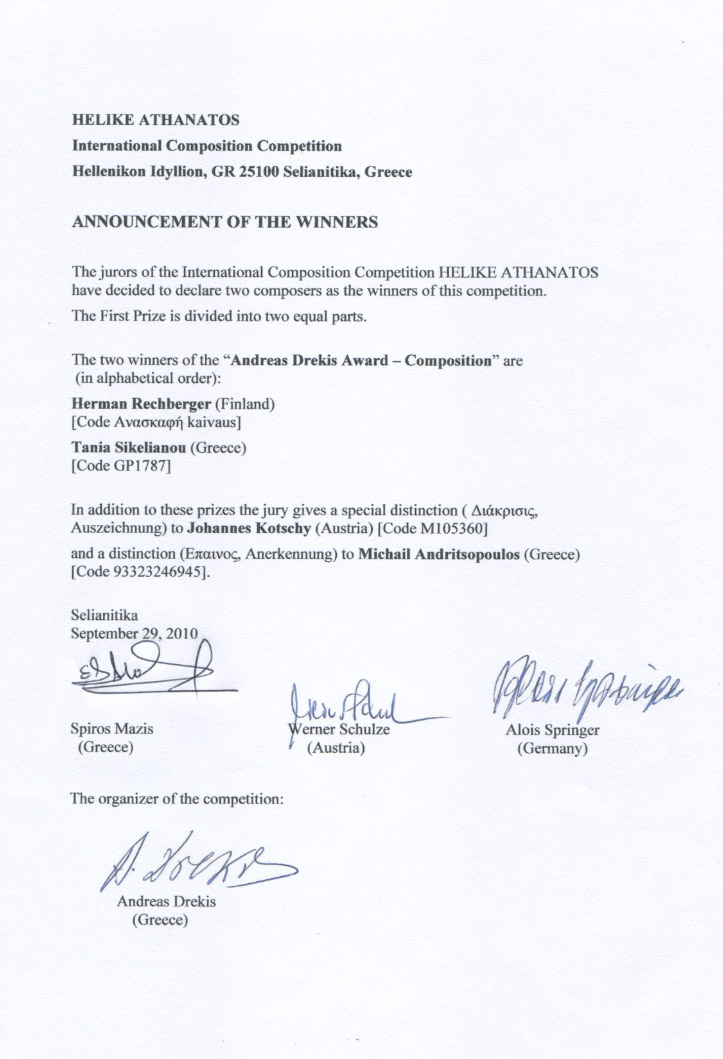
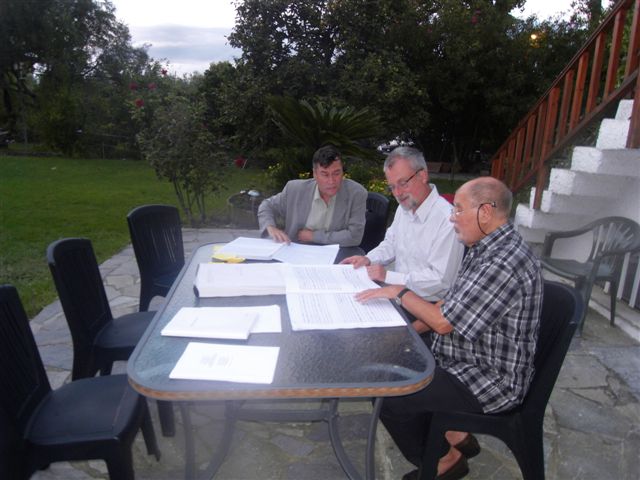
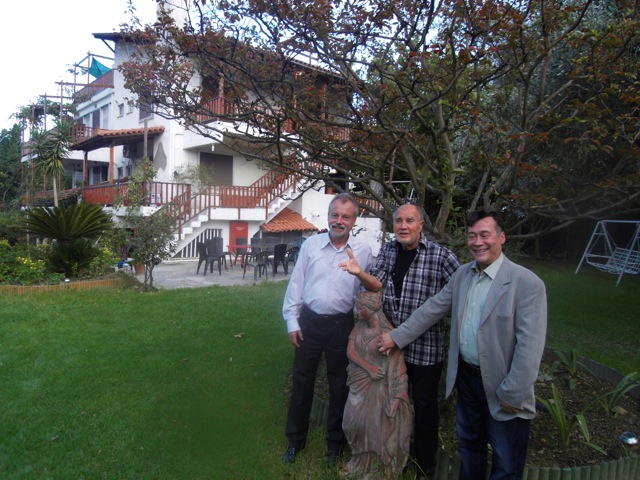
Jury: Werner Schulze, Alois Springer , Spyros Mazis
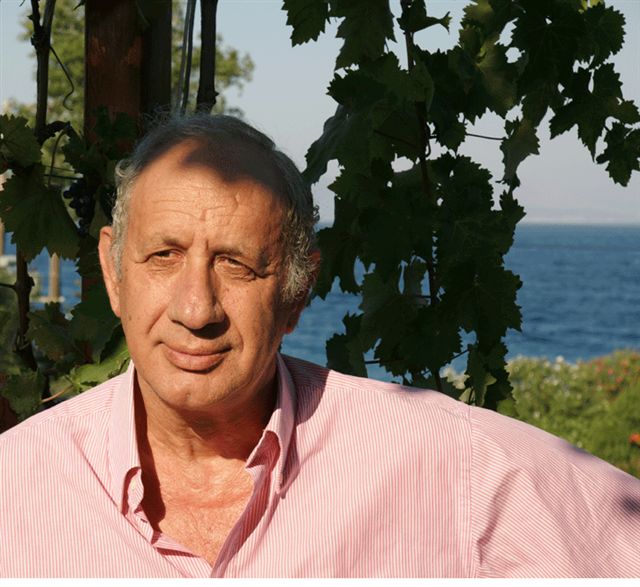
Andreas Drekis, head of jury, founder and leader of the international musical and cultural centre "Hellenikon Idyllion", Greece
The two Winners (2 first prizes) are:
First prize Tania Sikelianou (Greece) Websites: www.taniasikelianou.com
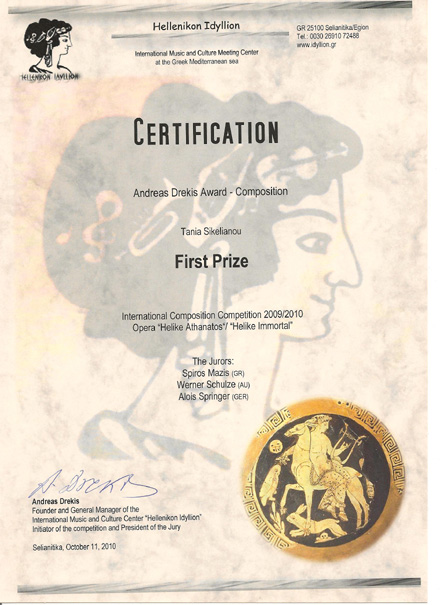
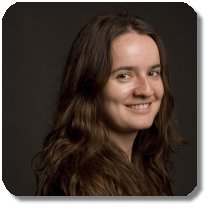
TANIA SIKELIANOU (GP 1787): WINNER of one of the two FIRST PRIZES COMMENT of ALOIS SPRINGER
As a chief conductor of major orchestras, even 5 times first place winner and one year working experience as assistant to Leonard Bernstein, not least from my literary, compositional experience, I do know the difficulty of the particular art to put an end to a recently completed work. If only every creative mind may want to bring his work to completion. Even the great Leonard Bernstein struggled with this final decision again and again. I mention this with regard to the temptation to add retouching in the scores.
Working on their own first and then consulting with the other members of the jury, the jury agreed on the main criteria.
The music of the score stands with its refreshing, contemporary relevance and the demonstration of diverse sounds in the middle of the recurring drama as well in the modern life as in the memory of great dramatic events in the past, with its ups and downs. They are musically empathized and observed to the smallest detail, creating new sound with the diversity of the modern orchestral sound. Turned into sound, it can be made accessible to future listeners.
This shows a talent for musical and dramatic presentation without sensationalism, which entitles high hopes.
The score in C features a unique clear-textured sound. In spite of so many unknown sounds this music will move the audience in its clarity, sensibility and a boundless imagination and get through to the audience directly, without translation, quasi intravenously. Because of this knowledge I have given the score GP1787 - in connection with the announcement - my voice and the well deserved first prize. The other competitors have also demonstrated great achievement and will find their way to reach people positively with their music.
My other reasons for giving this score the award of a first prize, without going too much into details, are the following:
It is almost the Dionysian pleasure in using the sonic possibilities of a modern orchestra body such as the use of tenor Records -bass Records and two harps, recorders. It is the flexible-free treatment and interweaving of voices with the orchestra as well as the improvisational element of tonal coloration that gives the players freedom, which - like freedom always does– is only socially involved in a predetermined period of time. This is the reason why there is formed an individual lively coloring caused by individual instruments without fixed notation and a vitality in spite of recurring repetition.
Choir and choral speech contribute to the tension, with its catchy repetitions - alternating men -, the vivid varying solos, some with voice singing.
Orchestra Instrumentation: blocky, well-defined identifiable sound blocks.
The high chamber music entitlement of the score demands to make the Work in its quality accessible to the public, not only in open-air performances but also in ambitious halls.
Overall impression: Consistent, clear, memorable, clear sounds, good dramatic tonal change of scenery, the variety of possibilities of sounds used by excellent instrumentation. Highest demands! ALOIS SPRINGER
TANIA SIKELIANOU (Partitur GP 1787, GREECE): WINNER of one of the two FIRST PRIZES
1) The work corresponds to the style of "contemporary music", which is now being maintained in many countries. It is related to the situation in Greece: However a performance may likely not meet the expectations of listeners, except being performed in Athens (Megalo Mousikes). Need of many rehearsals, only experienced musicians (43), singers (Chorus: 12) and soloists will achieve a high quality realization!
2) The musical arrangement (Instrumentation) targets a diversity of sound (woodwinds, bass, trumpet, harps and drums). Out of all submitted compositions this work is that one with the most nuances and the most vibrant work in its instrumentation: Choir also practicing choral speaking (Scene 1). Micro-intervals also being lead by the solo singers, always perceptible and based on ancient modes (page 36); solo parts (e.g. Cleanthes, Diotima, Estiarkhes)) often in the form of a sing-speaking.
3) The addition of two recorders is an enrichment, as far as they are used more or less soloistic [also with micro-intervals]. Their use in the Forte of the orchestra´s tutti should unnecessary.
4) The large dynamic ranges, as well as the tonal variety of the work, surely especially come into their own in a concert hall. Maybe that's why a concertant performance is to be chosen over a scenic realization? Anyway, an open air performance should be hardly possible or desirable.
5) The two harps are being used very skillfully. Also the shifting of the Voices into the orchestra is very smart.
6) In the score there is also given "tape": These are 12 different electronic sound fields,which produce an additional sound effect. 7) The composer has a good dramatic intuition. But perhaps the purely musical content has a greater significance than the normally required overall concept of an opera production? (See also point 4 with reference to a desirable concertant performance, where all nuances of the music would be shown to their advantage best.
Suggestions for changes (in the case of a realization of the work):
1) To have a critical look through some woodwind points in view of playability.
2) Recorders in the orchestra´s tutti: yes or no (page 63-68)? With reinforcements?
3) If there should be made adaptations in the libretto, corresponding small changes in the score are necessary. WERNER SCHULZE
Tania Sikelianou about her Work
The idea to compose an opera on an ancient Greek text was in my future plans. With the proclamation of the competition, I had the opportunity to compose an opera about ancient Helice, who has disappeared on the seabed near Aigio (Pelloponese, Greece) As the libretto makes a reference to ancient and modern times, I chose a combination of the ancient Greek scales in my contemporary composition: Gross Phrygian-Lydian, Lydian- Eoliko and Mixolydiko. More in particular every main character has a direct and special relationship with these scales. For instance Diotima, Kleanthes, Chorus, Estiarchis and Hypatia have different set of pitches in the opera. Furthermore the two flutes and harps have a high-profile role in the opera, so their position in the orchestra is next to the conductor (meaning two flutes - conductor- two harps) The two flutes represent the character Diotima and the two harps represent the character Kleanthis. During the opera ancient Greek sounds are presented in combination with sounds from a modern era. The patterns that I used 5 / 8, 6 / 8, 7 / 8 highlight in some way the Greek rhythm in modern music. The opera can be played in an original Opera House or in an open theater (with proper audio support if nessecery) Electronic music The twelve tones are generated by natural live recorded sounds (field recording) and computer programs such as: AC-Toolbox, Maxmsp, Ableton Live, in two channels. The reason for their creation is to give greater focus and uniqueness in some moments in the opera in conjunction with the orchestra.
Characters
Diotima (The adored lover): Dramatic coloratura Soprano Kleanthes (Diotima's lover): Dramatic Bass-Baritone/Low Baritone Estiarkhes (Host of the Symposium): Lirico-Leggero Tenor Dora (Greek archaeologist; research director): Actress Stephanos (American Physicist, research associate amateur archaeologist): Actor
Hypatia (Philosopher woman): Coloratura Mezzo-Soprano Philosophos I (Philosopher 1): Actor Philosophos II (Philosopher 2): Actor Kyrios I (Gentlemen 1): Actor
Kyrios II (Gentlemen 2): Actor Kefale (The executive): Actor Agroteros (Peasant): Actor Khoros (Choir): 6 women, 3 Dramatic/ Lyric Mezzo Soprano
3 Dramatic/ Contralto 6 men, 3 Tenor
3 Baritone/Bass
Stimmen (Voices): Orchestra players (Score pages:227,229,231240242,252) Dancers
CONTENTS
Introduction ( 1-5)
Scene I (6-68): In front of the temple of Poseidon in Helike. In the
middle of the stages is the bronze statue of Poseidon, next to it an altar. While singing the coir in form of a procession, led by a priest of Poseidon. The choir positions itself so that the men stand in the middle of the stage and the women on the left side.
Scene II (69-145): In a symposium-hall. The couple and their friend appear.
Prelude (146-147)
Scene III (148-205): Moonlit night, the open-air over the city, the pair appears.
Interlude of the orchestra (164-169)
Interlude of the orchestra (170-174): Earthquake
Scene IV (206-257): In the hall of the archaeological museum of Aegio, Session of the archaeological society of Aegio. In the center the executive and the archaeologist.
Prelude (258-260)
Scene V (261-303): The excavetion of Helike. The stage shows the ground of a big excavated area, in the background is a high earth-wall with archaeological marks and so on.Busy whirl of archaeologists and helpers-choir, adequate orchestra prelude.
Scene VI: Epilogue (304- 363,368). In the evening in front of the now cleared and solemnly decorated ruins of the Poseidon-temple. The choir of the citizens of Egion, Dora, the archaeologists and the gentlemen appear in a procession. Folk musicians are the incidental music.
Orchestra
1. Flute 1.Tenor Recorder 1. Bass Recorder 1.Oboe 1.English Horn 1.Clarinet in B flat 1.Bass Clarinet 1.Bassoon 1.Contra Bassoon 2.Horns in F 2.Trumpets in C 1. Trombone 1.Bass Trombone 1.Bass Tuba Timpanis (D-A, F-C,Bflat -F,D-A) Percussion: 2 players 2 Harps 6 Violins I 6 Violins II 4 Violas 3 Violoncellos 3 Double Basses Tape: 1-12 Tracks
The score is written in C
The Contra Bassoon and the Double Basses sound one octave lower than notated The Bass Recorder sounds an octave higher
On certain moments in the piece the strings must be performed 'divisi' (this is identified in the score).
Percussion Instruments
1st Player:
Tubular Bells Tam tam Bass Drum (Vertical Position) Chinese Cymbal Suspended Cymbal Woodblock(Medium) low-high Triangle Marimba Thunder Sheet
2nd Player:
Tam tam Bass Drum(Horizontally Position) Chinese Cymbal Suspended Cymbal Triangle Vibraphone Thunder Sheet
Orchestra 45 people, 4 vocal soloists, 8 actors, choir 12 people, unknown number of dancers =>all in all 69 persons plus dancers
For any further information or if there are any more questions on the works and/or their realization,we can also get you in touch with the composers.
Herman Rechberger First prize (Finland) Website: http://sonopt.pp.fi/
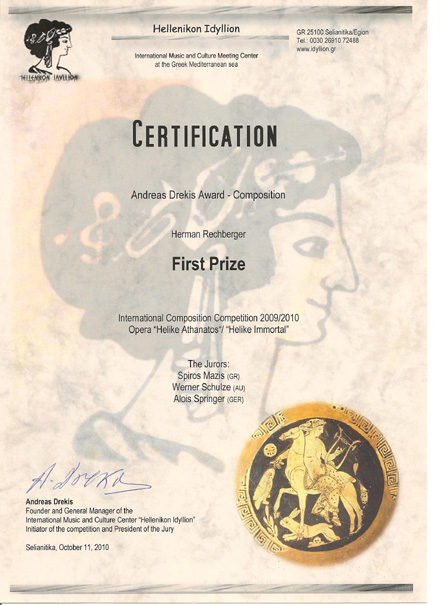
HERMAN RECHBERGER ("Kaivaus"): WINNER of one of the two FIRST PRIZES COMMENT of ALOIS SPRINGER
As a chief conductor of major orchestras, even 5 times first place winner and one year working experience as assistant to Leonard Bernstein, not least from my literary, compositional experience, I do know the difficulty of the particular art to put an end to a recently completed work. If only every creative mind may want to bring his work to completion. Even the great Leonard Bernstein struggled with this final decision again and again. I mention this with regard to the temptation to add retouching in the scores.
Working on their own first and then consulting with the other members of the jury, the jury agreed on the main criteria.
The music of your score will reach people almost immediately in its clarity, simplicity and modesty, without translation - quasi intravenously. Because this knowledge I gave the score No. 2 - in connection with the announcement - my voice, the well deserved first prize.
The other competitors have also demonstrated great achievement and will find their way to reach people positively with their music.
Other reasons for giving this score the award of a first prize are the following ones:
The music of your score is partly conventional, partly minimalistic, but it reaches the audience directly in its clarity and simplicity, without translation - quasi intravenously. Because of this knowledge of mine I have decided that your score is worthy for the first Price.
The repetitive singing in the work, which partially resembles litany, emphasizes to a large extend the word and the Greek text. It leaves space for the agogic design to the conductor and the performers, which can combat impressively a mistakenly rising boredom.
The performance, with its spatial requirements and needs will show what retouchings may be absolutely necessary to bring the work to the highest level of development.
The rhythm of the chorus is so catchy that even the most uninvolved person could not help himself to become an actor. The simple handicraft excellent orchestration and instrumentation in conjunction with the choir and the soloists is because of skillful doubling of the votes clear, mutually supportive and thereby gives both the lighter and the heavier parts of the score the for the joy of playing and making music necessary zero gravity.
The challenge of the score is in the facility, not in the more difficult passages.
The vocal soloists are easily realizable by the singers, they compel as well highlights in their necessary development as relaxations, so that the listener can be taken internally in the ebb and flow of movement.
The dance will still have to prove its effect on the audience in practice.
The overall impression is: consistent, long lasting comprehensible, impressive by simple structure and therefore close to the audience, effectively representable although not provocative but that's the reason why it is challenging and has got performance value- meaningful for audience and performers. ALOIS SPRINGER
HERMAN RECHBERGER (Partitur Anaskafi Kaivaus, FINLAND): WINNER of one of the two FIRST PRIZES COMMENT of WERNER SCHULZE
1) Uniform cast of the work: if being bad interpreted this can be lengthy/ boring, but if being interpreted well it can leave a long lasting impression to the audience.
2) The composer combines some principles of "minimal music" with a Greek text. I am convinced that this is an idea that works - especially in case of a semi-or fully-staged performance. That´s why I recommend this: A concertant performance is less desirable than a staged realization; as well as open air performances are desirable (for example in the ancient theaters of Argos or Oiniades, or maybe one day in Aigeira). (Orchestra: ca. 40, Chorus: 16 would be good, minimum 12). Diotimas´ / Cleanthes´ return being depicted in the antique way with a crane (Deus ex machina)?
3) The composer has a close relationship with the Greek language:
- e.g. the rhythm of the chorus
-as well as the close relationship to "(ancient) Greek atmosphere".
4) The composer has kept the scenic realization in mind:
-
The choir will be able to learn to memorize his part well. Singing and acting at the same time will be possible without problems;
- The libretto was not set to music strictly 1:1, but it was handled dramatically.
5) The composer is a pragmatist:
- There is nothing in the orchestra, which is not possible, but at the same time the work is a challenge for any musician: some things do not look difficult, but are far away from being easy;
- A conversation between the composer and director will certainly be fruitful, as there are several possibilities of variations and probably also some passages, which can be deleted.
6) The composer has a good sense for dramatic.
7) Santouri and Laouto are an enrichment! There can also be achieved interesting colors with synthesizer. One detail: I like that the composer manages the opera with one Clarinet (instead of 2)
Suggestions for changes (in the case of a realization of the work):
1) There are still some small imperfections in the score (which is not a problem!), e.g. a word is missing in the text.
2) Kleanthes sings the whole Sappho- song "Phainetai moi keinos", whereas Diotima sings only 1 verse. This should be reconsidered.
3) The composer should not have an instrument companying the voice with the same melody so often. Maybe think about writing "ad lib"?
4) Perhaps you should reconsider the "string underlay" during solo passages of the singers? Some of these may be eliminated, or rather solos instead of tutti. The "Greek folk dance"- like part at the end does not have the same quality as the whole composition. WERNER SCHULZE
Herman Rechberger about his Work
Ancient languages and their cultures have been always a challenge for me. Let me put it like that: Languages contain for me clearly all musical parametres: Melody, pitch, intonation, phrasing, rhythm, expression and to a certain extend even harmony. Languages posess, like music, a locigal structure, a grammar, a vocabulary.
1996 I wrote my first church opera after a libretto written by myself in Latein. In numerous other vocal works I have used texts in Sanskrit, the Inka language Nahuatl, Ewe, Chinese, Akkadian, Old Egyptian and Koïné. Though, when receiving the attic libretto, I thought "Why not an opera in Ancient Greek?"
The libretto by Franz Knappik (inclusive quotations from Sappho and Alkman, the documentations of the earthquake by Strabon and Pausanius, as well as a love-poem in New Greek by Andreas Drekis) is in ist structure a successful combination of Old and New and ist dramaturgy offers a variety of compositional solutions. When building the concept of my version of "Helike Athanatos" I was lead by the idea of an open air performance in an ancient amphitheatre. This is partly also the rerason why the the music is rather archaic - with a minimalistic touch - than modernistic. The tone material uses mainly greek modes (dorian, phrygian, locrian) but also scales from folk music and rebetika (hijaz, kartzigar, neverezi, sabah).
The orchestration contains also a Synthesizer, as well as a Santouri and a Laouto, which guarantee in many places of the score a "greek flair". The use of a single, almost solistic clarinet in the orchestra gives sometimes the illusion of folkmusic from Epirus. The choir has, like in ancient plays, mostly a narrative role (e.g. in the documents of Strabon and Pausanius), in some other spots ritual (the feast in honour of Poseidon) and lyrical functions (poem of Alkman).
Very accurately I treated the rhythm of the Ancient Greek language. During my composing process, I began with analyzing each sentence. The rhythm of the entire opera is controlled by the rhythm of the language.
Some of the parts in the libretto are treated molodramatically. That means, that the dialogues (e.g. in the symposium and the archaelogic congress are spoken, with instrumental underpainting and commentaries. Thus the instruments are getting involved in the spoken dialogues. The roles are clearly designed: There are actually only two "surviving" protagonists (Kleánthes [baritone] and Diotíma [mezzosoprano]. Most of the other roles are metamorphoses (so, the host of the symposion changes later into the chairman of the archaeologigal congress, the two philosophers take the personage of a banker and a politician). Dora and Steve with their passion for archaeology are in a certain sense relatives of the loving couple Diotíma-Kleánthes (the musical link is the returning "theme of the vase").
Maybe one of the most difficult tasks was to create a musically expressive scene of an earthquake. Such a destructive event is normally a matter of only a few seconds. After listening to many recording of earthquakes, I came to the conclusion, that the only way to reflect such a natural desaster, is to create a sound-colour-composition including the emotions of those concerned with it. Therefore I have in the Tsunami part given the choir an instrumental part, which should, at the same time, be understood as a lament. May my opera "Helike Athanatos" through an open-air performance pay a well-deserved tribute to the rediscovery of this, once so glorious city. Herman Rechberger
Herman Rechberger: Helike Athanatos
The orchestra contains:
- 2 flutes
- 2 oboes
- 1 clarinet in Bb
- 2 bassoons
- 1 electric piano (with MIDI - instruments)
- 1 Laouto, Greek or substituted by a guitar (alternative part available) This substitution should only be considered if the original instrument is not available. The color of this instrument is important, because it is close to the sound of the antique Lyra.
- 1 Santouri (dulcimer), or substituted by a harp (single pedal harp ist suitable). In this case, the part has to be adapted. timpanis
- 2 french horns in F
- 2 Bb trumpets
- 2 trombones
- 6 first violins
- 4 second violins
- 3 violas
- 2 violoncellos
- 2 double basses
- 34 musicians (minimum) choir: 4 sopranos - 4 altos - 4 tenors - 4 basses (minimum) or 6 6 5 4 (or more) if available
- DIOTIMA (the adored lover) mezzosoprano
- KLEANTHES (lover of Doitima) high baryton
- ESTIARKHES (host of the symposium) actor
- DORA (Greek archaelogists) singing actor, with easy vocal part
- STEPHANOS (cooperating archaelogists) actor
- HYPATIA (philosopher woman) actor P
- HILOSOPHOS II & II (philosophers I & II) actors
- KYRIOS I (1st gentleman) tenor KYRIOS II (2nd gentleman) tenor
- KEFALE (chairman) actor
- AGROTEROS (farmer) voice from the choir
Orchestra at least 34 people,choir at least 16 people, 4 vocal soloists, 8 speaking parts => all in all at least 62 persons
For any further information or if there are any more questions on the works and/or their realization,we can also get you in touch with the composers
Johannes Kotschy A special Distincktion Price , (Austria ) Websites: www.newkeyboard.de www.naturton-musik.dewww.ekmelic-music.org
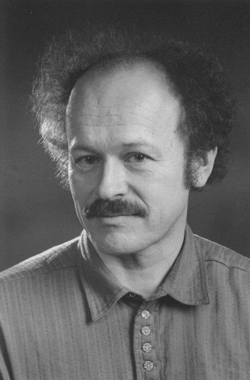
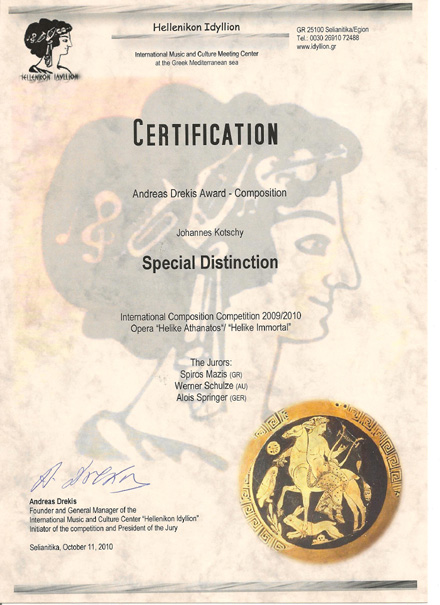
Johannes Kotschy about his Work
Three things belong to my music: material, craft and imagination. Material means notes - not only the (few) twelve semitones of our occidental music, but all pitches you can imagine. Craft means the special knowledge about acoustic interrelations of tones, pitches and sounds. And imagination is my personal contribution to my compositions, it serves for creative action. All experiences and feelings I have are involved, whether they come from literature, painting, arts, from nature, or from human beings and their activities, and deeply from inside. It is my aim to contact the listener wihout using words or explanations. I hope, my music will be able to transmit sensations that are inexpressible. As Beethoven once said: "From heart - may it touch the hearts."
For any further information or if there are any more questions on the works and/or their realization,we can also get you in touch with the composers.
JOHANNES KOTSCHY (M 10 536): WINNER of a SPECIAL AWARD COMMENT of ALOIS SPRINGER
As a chief conductor of major orchestras, even 5 times first place winner and one year working experience as assistant to Leonard Bernstein, not least from my literary, compositional experience, I do know the difficulty of the particular art to put an end to a recently completed work. If only every creative mind may want to bring his work to completion. Even the great Leonard Bernstein struggled with this final decision again and again. I mention this with regard to the temptation to add retouching in the scores.
Working on their own first and then consulting with the other members of the jury, the jury agreed on the main criteria.
So it is even more amazing to show the plant, that is still growing, the unborn child to a new pair of eyes and to hope for the judgement by a jury.
Considering the great unfinished works of the world literature like the B minor D 759 of F. Schubert or the 10th Symphony by G. Mahler or A. Bruckner's 90th Symphony in D minor, for your "unfinished", nothing stands in the way to finally complete your unfinished work.
Even the handwriting in your score is inviting to the exploration and exciting discovery of unknown paths. And there is a lot to discover.
Apart from your craftsmanship, which is the requirement for a realization of your own imagination, the totally homogenous general representation of the work is immediately visible, from the first to the last note. It is a very personal and unique musical manuscript and language and this way it is immediately recognizable. A great advantage.
This impression is intensified by the Dionysian sound idea of a large string apparatus of at least 8, 6, 4, 2-3 strings. Because the strings form the sound, and their sound can be formed. On the other hand, the soloists-winds should have soloistic skills.
But this demand is supported by the score with its creative wide-ranging ideas. The soloists give this score the necessary individual brilliance by their individual abilities and emotions in the construction of the highlights of the drama and the following calming down. This should be easy after the beautiful course of the musical lines. They would be the splendor of the string sound you demanded. This is required by your score that asks in its complexity and at the same time simplicity for the engagement with it during intensive rehearsals. The musicians should be professionals to perform the work in high quality.
The composeralso leaves the twelve-tone scale at certain intervals, which gives the whole thing an exciting appeal of ancient and modern tonality.
You show all these possibilities for broad-based drama and lively breathing dynamics with clear signs. The choirs - alternating men and women - and the lyric-dramatic solo parts leave in the uniqueness of their statement, with the development of tension and distinct accents up to highlights no doubt about the imagination and the creative will of the composer. The congenial connection with the libretto seems especially successful.
The same applies for the both conventional, but because of that also flexible tempo designations such as "Allegro energico" or "Moderato, ma non moto", which leave interpretive space depending on the particular situation of the performance. This would be relevant especially for open-air performances that are indeed realizable in a desirable way if the details are payed attention.
All this is now waiting for the completion and would be possibly award-worthy of a first prize. For now only one thing remains to be said:
For the creative process of your work career, I wish you the creative restlessness, but also patience, which is necessary to come to rest.
In this way, a high level of recognition and appreciation for your work by the jury is guaranteed to you. ALOIS SPRINGER
Michael Andritsopoulos
A Distinktion price (Greece)
Website: http://www.thearchitect.gr/projects/mixalis/site/
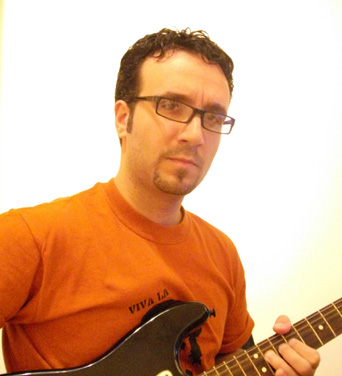
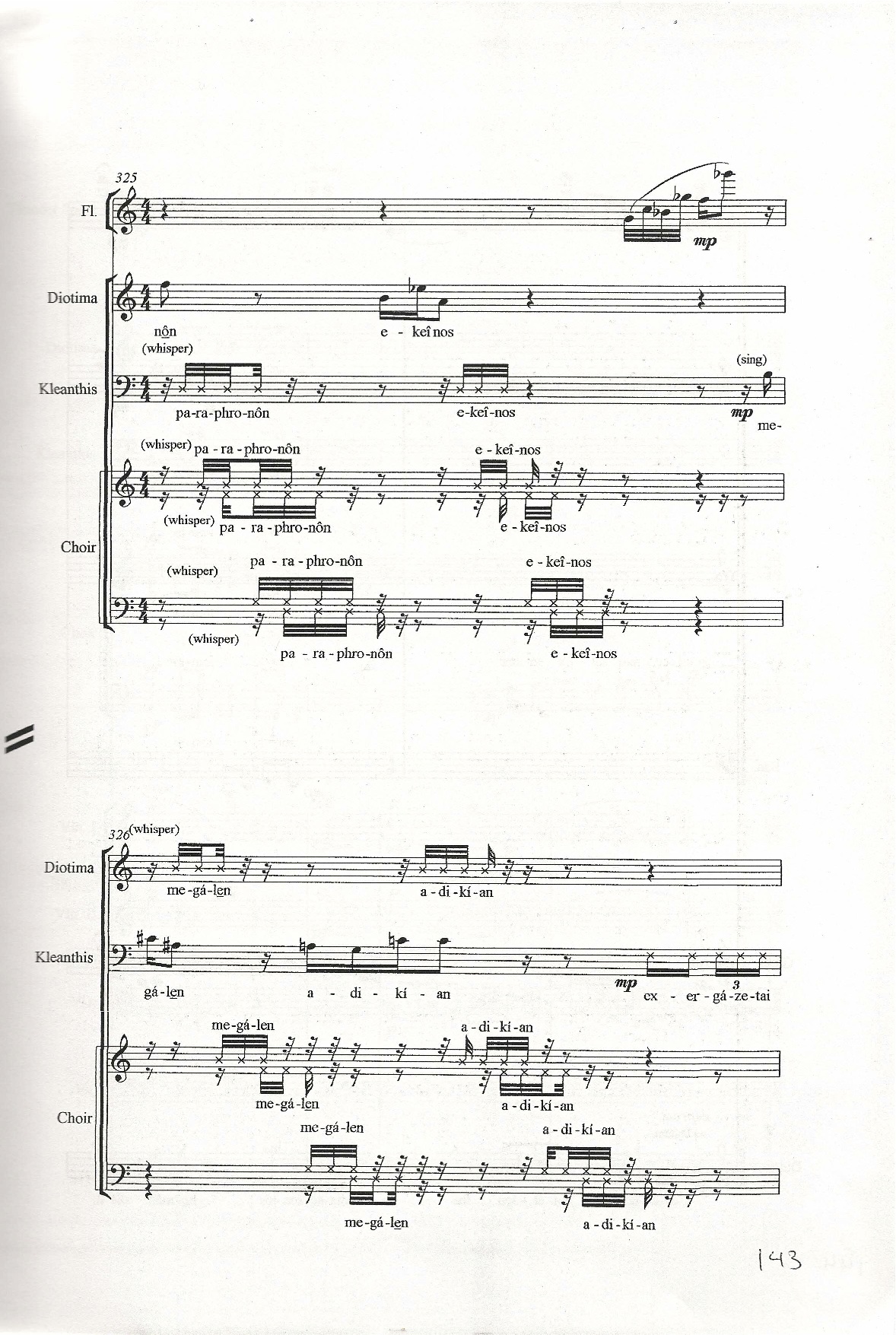
MICHAEL ANDRITSOPOULOS (Partitur 933232469945): Awarding of a RECOGNITION COMMENT of ALOIS SPRINGER;
As a chief conductor of major orchestras, even 5 times first place winner and one year working experience as assistant to Leonard Bernstein, not least from my literary, compositional experience, I do know the difficulty of the particular art to put an end to a recently completed work. If only every creative mind may want to bring his work to completion. Even the great Leonard Bernstein struggled with this final decision again and again. I mention this with regard to the temptation to add retouching in the scores.
Working on their own first and then consulting with the other members of the jury, the jury agreed on the main criteria.
The music of your score is clear in its structure and the musical composition is skillful, initially only seeming to be in the conventional type of the four part sentence, but then very impressive in the outstanding elements of the contemporary parts, which give the instruments improvisational freedom of creation. In this way a flexible variety of musical sound creation will surely be reached, which gives the work its vitality.
The solo parts in form of sing-speaking along with the catchy rhythmical parts of the choir are exciting in the development of climax and retirement.
The score is full of great ideas with high demands, which requires a lot: multiple rehearsal time, highly skilled musicians and singers and a confrontation with the work that demands a lot from the orchestra members and especially from the audience. These are for example the intricate movements in the orchestra, the choir and the soloists in connection with the libretto and last but not least in the rhythm section.
Considering these thoughts it resulted difficult for me to give my voice for the award to you, although your work was close to the award of a 1st Prize.
A high level of recognition and appreciation by the jury for your work is guaranteed to you.
I wish you a realization of high quality for your work. ALOIS SPRINGER
Michael Andritsopoulos – analysis of the opera Helike Athanatos
The libretto and the idea of this opera was very intriguing. The need to blend the new with the old was the one which provided me with the harmonic material from the beginning. The old ways and scales gave their sound to the main characters, for example in the first duet of Diotima kai Kleanthis , Diotima sings in a diatonic modal way while the orchestra accompanies in a very busy contrapuntal style and Kleanthis sings in a multimodal way while the orchestra surrounds him with homophonic style.
Old dances give their rhythms but in a more modern style, combined in multirhythmical dances. The use of divisi at the string section in the beginning summons memories of programme music as it magnifies the waves of Poseidon and in the middle an atonal surrounding with contrapuntal action makes an earthquake.
Also intriguing for me was to make it all happen with the minimum of performers so the instruments and the musicians needed for the opera is at least the following :
- 1 piccolo, 1 flute, 1 oboe, 1 clarinet in Bb, 1 Bassoon
- 1 trumpet in Bb, 1 horn in F, 1 trombone, 1 tuba
- 1 harp
- 2 percussionists ( for timpani, cymbals, marimba - not at the same time)
- String section (at least 6 first and 6 second violins and 2 violas …)
- Choir (of at least 8 people -SATB)
- And the soloists : 1 soprano, 2 mezzo sopranos, 2 tenors, 1 bass, 2 baritones
- Orchestra 26 people, 8 vocal soloists, choir at least 8 people (expendable to 16,24,32,etc. people) => all in all at least 42 persons


